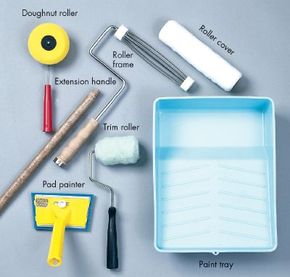For large, flat surface areas like walls and ceilings, paint rollers will help you get the job done in about half the amount of time it would take with a paintbrush. Most painters use brushes for trim work and around windows and doors, then turn to rollers to fill in the big blank spaces. Rollers for painting flat areas come in varying widths -- from 4 to 18 inches -- but the two most common sizes for interior jobs are 7 inches and 9 inches wide.
Paint rollers intended for wall or ceiling painting have handles made of plastic or wood that may have been hollowed out and machined to accept an extension handle. They also have a metal or plastic frame that is slipped inside a roller cover. Of the two types, the metal-rib version (also known as a bird cage or spring-metal frame) is best because it's easier to clean and less likely to stick to the inside of the roller cover.
Advertisement
The type of roller cover you should buy is largely determined by the kind of paint you'll be using, but they are all fiber-covered or urethane-foam-covered cylinders that soak up paint from a tray and then release it when rolled over a flat surface. The rolling action creates a vacuum that actually pulls the paint off the roller. Made of lamb's wool, mohair, Dynel, acetate, or polyurethane foam, most rollers are labeled with the kind of paint for which they are intended to be used. Choose your roller cover accordingly.
The roller package will also identify the length of the roller cover's nap, or pile, which can vary from 1/16 inch to 11/2 inches. For rough surfaces, use the long naps; choose short ones for smooth surfaces. The pile is attached to a tube that slips over the roller's plastic or cardboard frame.
Advertisement

